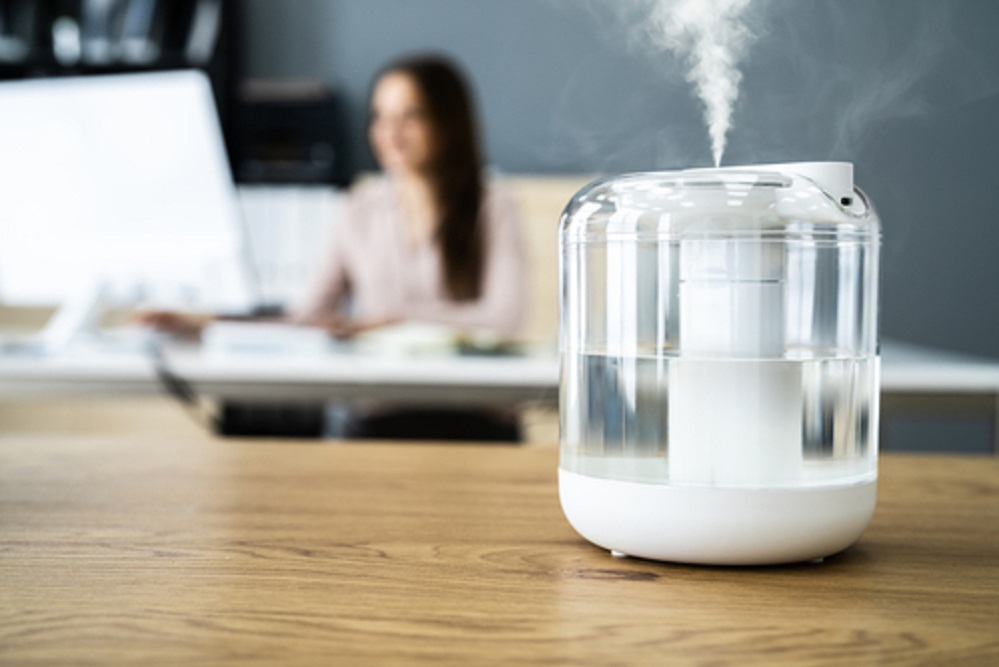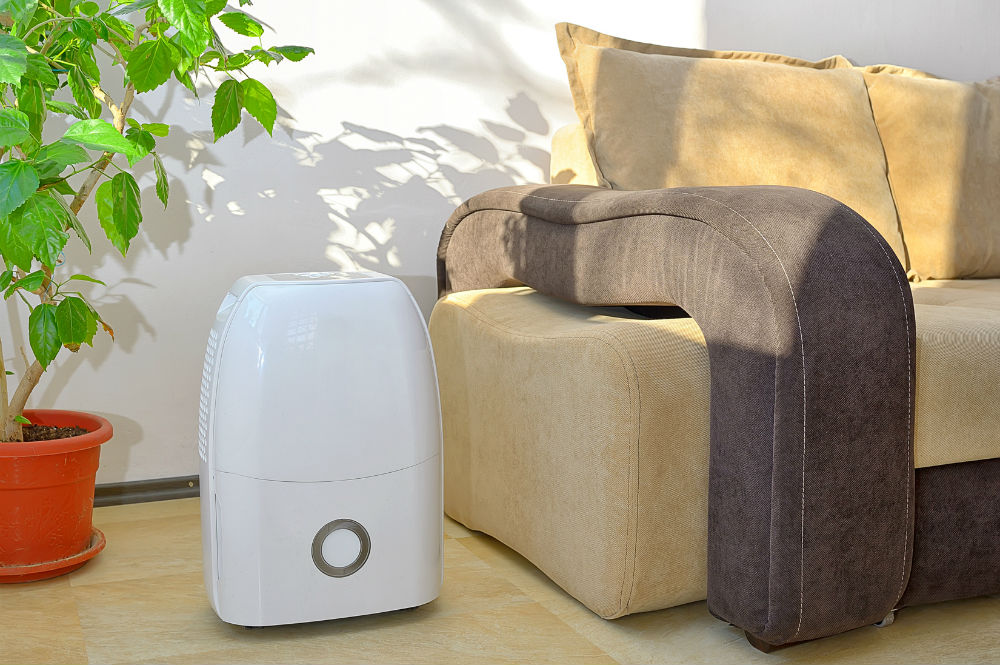Extremely dry weather can lead to eczema, allergies, cough, and plenty of trouble for adults and kids.
Humidifiers add moisture to the air and maintain the humidity level balanced in place. It makes the air of space comfortable for you while keeping allergens and bacteria in check.
But to maximize their benefit, where should you place a humidifier in your room? What considerations should be taken into account?
In this article, you will learn how to place your humidifier correctly to eliminate condensation risk and to maximize the health benefits.
Where Should You Place Your Humidifier?
First of all, make sure you are using a correctly-sized humidifier. Every humidifier is designed for a limited coverage area in square feet. You need to buy a humidifier that fits your room size, or placement won’t make a difference.
Height Above Floor
Whether you are using an ultrasonic humidifier or a misting unit, you want to keep your humidifier above ground level. This is because if it is placed on the floor, the area close to the humidifier can get moist and slippery and damage the floor.
If placed directly on carpet, this damp area may also promote growth of mildew and bacteria in the carpet and the flooring below.
It’s much better to set the humidifier on a desk or platform at least two feet over from the ground. You can also put a towel under the humidifier to protect the furniture from moisture.
How a Humidifier Works
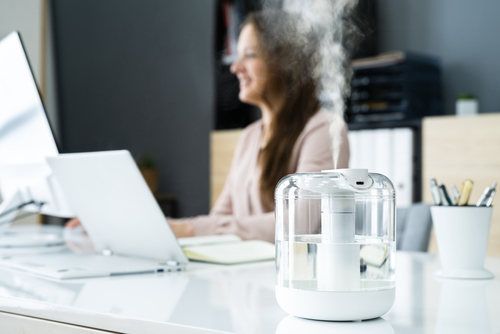
Placing a humidifier serves to convert liquid water into a fine mist released into a space to increase the humidity.
While not all require electricity to accomplish this, the most typical (and often the best ones) use electricity from a standard electrical outlet to operate.
The power electronics function to use electrical power to induce a vaporizer component. A vaporizer is often one of a few forms:
- Thermal (heating element) vaporize
- Ultrasonic
- Electro-mechanical
Ultrasonic thermal (warm mist) and (cool mist) kinds are now the most often sold.
The vaporizer turns the liquid form of water into a fine mist which rises through an exit way and out a nozzle to the room’s atmosphere.
This adds moisture humidity) to the area’s atmosphere and enhances health, comfort, and relief from low-humidity issues.
What Is Your Room's Relative Humidity?
The humidity level of a room ought to be assessed before putting in a humidifier. A hygrometer is helpful for this purpose and measures the humidity level of the room.
If it’s below 40%, then it’s possible to add some moisture into the air. If the hygrometer shows humidity 50%, then a humidifier isn’t required as excessive humidity in an area can cause mold and other difficulties within the room.
Basic Operation
The good news is that humidifiers are very simple appliances that could not be easier to operate.
Here are the basic steps involved:
- Place the unit on a suitable surface
- Remove the tank and remove the tank cap
- Fill the tank with clean water of the recommended type (purified, distilled, or tap)
- Replace the cap and tighten it securely
- Place the water tank back into the humidifier base, taking care to prevent spills
- Switch on the humidifier and adjust as desired
With most small and inexpensive models, you’ll have to refill the water tank after a few hours of operation.
Some models, however, will provide up to 9 to 24 hours of operation between refills. The amount of time it needs depends on both the output of the humidifier and the tank dimensions of this model you purchase.
How to Know When You Need a Humidifier (and How to Check)
Humidity measured as a percent on a scale of 0-100%, and comparative to the atmosphere’s temperature. Hence, the title you will frequently hear: “Relative Humidity.”
Generally speaking, the body feels best with relative humidity above 30% and 60% and under.
However, the perfect range for humidity in your house is 40-50%. Your objective is not to have it perfectly at a predetermined number which is not realistic or necessary.
The ideal amount of humidity is the amount you feel comfortable at and solve healthier and dry air symptoms for you, your child, or your home and loved ones. A great guideline is to aim for approximately 50%.
When the level starts to reach 30 percent and below; it is time to use your humidifier.
Severe dry air conditions start to become evident at about 30 percent and below. In humid climates and during winter, the amount can fall to under 20%!
You might not know it but even allergy symptoms are less troubling if the air is kept to a healthy moisture level,.As we mentioned previously, it is because dry air allows pollutants to finally become more of an issue and move about more freely.
How to Check Humidity Levels
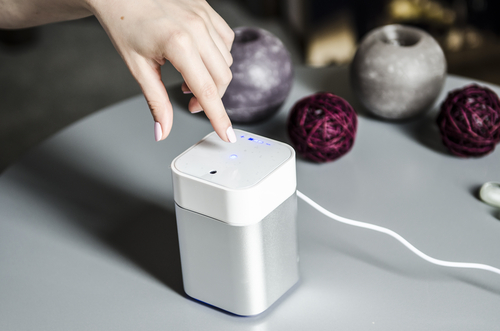
Checking the humidity of your room is easy if you use the right instrument – a hygrometer, in this case.
We recommend buying a $5-$10 digital hygrometer such as the amazingly small ThermaPro digital humidity gauge to keep an eye on room temperature and relative humidity.
Humidifier Types

While they’re often somewhat similar in the way they look from the outside, there are some important differences to understand.
There are 3 types of humidifiers available for home and office use:
- Cool mist
- Warm mist
- Evaporative
Warm mist and cool mist units are similar but have some unique differences.
Evaporative versions are less common but have some benefits (and drawbacks) the other two do not have.
-
1. Warm mist humidifiers create water vapor using electric heating elements and emit a vapor that is like a lukewarm steam. They're best for relieving symptoms of congestion, colds, and at wintertime.
The disadvantage of warm mist units is they add warmth to a room as the water mist released warms until it escapes the system. Plus, they do not have a dial controller like cool mist versions and frequently cannot humidify a very large room or entire apartment.
-
2. Cool mist humidifiers typically utilize low-power methods like ultrasonic sound waves to generate a super-fine mist at room temperature. They're the best type of humidifier to buy for saving energy and are especially well-suited to drier climates. They also feature near-silent operation, and several models allow for fine-tuned control over the humidity level in your room.
- 3. Evaporative humidifiers work exactly as you might imagine: water evaporates from soaked pads inside the unit as a fan blows room air over them, resulting in slightly more humid air returned into the room. One limitation of evaporative humidifiers is they can't increase a room's humidity level very high (over 60%).
Should You Place a Humidifier Near the Bed?
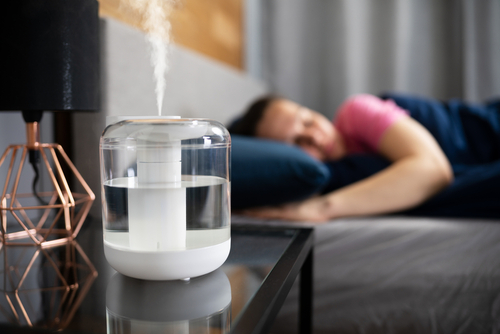
Where to place a humidifier in your bedroom depends upon several factors.
The first and most important consideration is the type of humidifier.
If you purchased a cool-mist humidifier to allow you to sleep more comfortably, then it’s fine to place it near your bed.
Placing a humidifier beside your bed is also a great idea if your humidifier includes an integrated filter to alleviate allergies. If you are using the device to clean the bedroom air, then your humidifier should be as close to your bed as you can with the exhaust vents pointed towards your bed, so you get the full benefit of clean air.
A warm mist system, on the other hand, should not be placed close to your bed or near any other potentially flammable materials while you’re asleep, because warm mist humidifiers use heating elements to boil water. This presents a potential fire and electrical hazard.
The second major factor to consider is whether the humidity can be auto-controlled by the unit through the night. If your room becomes too humid, your sheets and comforter can become moist which can promote growth of bacteria and mold. And it feels awful. Look for units with humidistats and auto-control features to prevent this from happening.
The third major consideration is the type of water used in the humidifier.
If you’re using tap water to fill your tank, you may notice a fine white dust accumulating on your bedroom furniture. These are mineral deposits from hard tap water that are discharged along with the moisture into the air. Using demineralizing pills can help, but the best way to reduce the white dust is to use filtered and distilled water in the humidifier.
A fourth factor to consider: how clean is your humidifier?.
A humidifier that’s not adequately cleaned regularly shouldn’t be placed close to your bed. Some humidifiers include air filters that must be checked and cleaned regularly. If you don’t follow the manufacturer’s regular cleaning instructions, then your bedroom humidifier can become a breeding ground for mold, mildew, bacteria, and other allergens.
The final consideration is the noise level of your humidifier. All humidifiers create noise. Some are quieter than others, but even the best ultrasonic cool mist units emit noise. Having your humidifier too close to your bed can ruin your sleep if your it generates the wrong kind of sound. To be safe, look for humidifiers that emit less than 55dB.
Placing A Humidifier in the Baby's Room
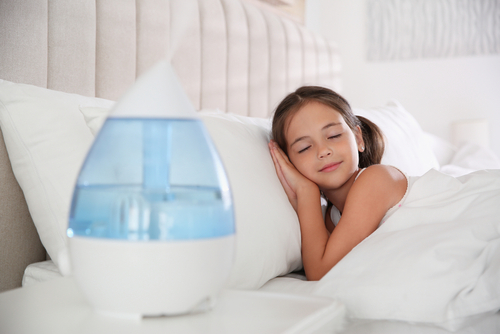
A humidifier in the baby’s room can help your child if s/he is experiencing a cough, chills, or congestion.
But without placing the humidifier in a suitable area, you can risk your child’s comfort and safety.
Warm mist humidifiers are among the best choices for a baby’s room because the warm steam can really ease congestion and help your baby breathe. Boiling water also kills any bacteria or virus in the water.
But because warm mist units use electric heating elements that can boil water, they do present a moderate safety risk in a child’s room. So make sure you place the humidifier at a safe distance from your child’s bed.
If your child is playing in the room with a humidifier, place it out of arm’s reach.
Where Humidifiers Should Never Be Placed
The humidifier should never be placed near your central air system’s intake vent, otherwise you will immediately draw the moisture from the room.
Additionally, make sure the humidifier isn’t placed anywhere near an energetic child who could accidentally overturn it.
Humidifiers are helpful in dry weather and provide relief from several respiratory issues, but their placement is vital.
You can take maximum advantage of it by placing it in the ideal location.
Follow the instructions carefully to ensure that your loved ones, your furniture, and your health remain safe from harm.
Final Thoughts
Humidifiers can be amazingly helpful in relieving respiratory issues and making a room more comfortable, but their placement is vital.
You can maximize the benefits and minimize the risks by placing your humidifier in the right location.
Follow the instructions carefully to ensure that your loved ones, your furniture, and your health remain safe from harm.
I’m a degreed ME (mechanical engineer) who is passionate about machines of all kinds. I created MachineWonders.com as a way to connect with others who love machines like me – or need help choosing one for their needs, application, or situation.

